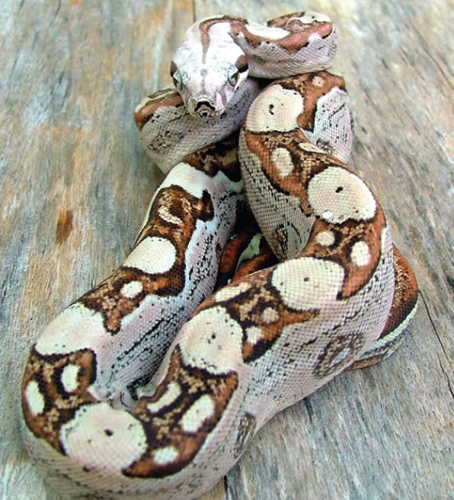Unauthorized Reproduction Not Prohibited
By Morgan Ryan
Fatherless boa litters extend the realm of parthenogenic vertebrates
Fatherless boa litters extend the realm of parthenogenic vertebrates

DOI: 10.1511/2011.88.30
Evolution went to a great deal of trouble to conjure up the apparatus of sexual reproduction in animals: chromosome-sorting machinery in the cell, organs of intromission and oviposition, crests and trumpets and scent and pretty fans to get attention. In theory it’s all worth it, paying the dividend of constantly refreshed genetic diversity.
Yet here and there in the animal kingdom, organisms withdraw from the mating derby. Parthenogenesis is the production of offspring without fertilization by a male. It seems a plausible enough lifestyle choice for the tiny and squiggly—say, rotifers, aphids and nematode worms. The idea takes a bit more getting used to for larger animals such as some lizards and a few birds, but anyone who studies biology learns to be unsurprised by the exotic tendrils that form in evolutionary space. So long as things don’t get out of hand.

Image courtesy of Warren Booth.
“I have literally gotten no work done this week because of answering phone calls and emails,” says Warren Booth of North Carolina State University, who recently reported the first scientifically confirmed case of parthenogenesis in a boa constrictor in Biology Letters. The unusual litter came to his attention through a network of boa enthusiasts, one of whom had a female with two litters exhibiting anomalous recessive coloration. Booth agreed to apply a microsatellite DNA fingerprinting test he’d developed for another study to see if something strange had occurred. “I thought it was going to be stored sperm or local males,” Booth explained. “I said, ‘Send me the shed skin.’”
Earlier examinations of parthenogenesis had relied mainly on behavioral and perhaps surgical analyses. Using DNA fingerprinting, Booth demonstrated with an infinitesimal margin of error that the offspring were, allele by allele, including that rare color trait, genetic matches of the mother.
Oddly enough, Booth’s colleague at N.C. State and coauthor of the Biology Letters paper, Edward Vargo, reported a similar discovery in 2009 in Science, showing that subterranean termites produce queen successors by parthenogenesis. (Neither researcher had a special professional interest in the topic beforehand.) Odder still, Booth was a Ph.D. student in the lab of Paulo Prodöhl when Prodöhl was coauthor of a 2008 paper with Demian Chapman reporting parthenogenesis in—most unexpectedly—hammerhead sharks.
“It’s kind of like parthenogenesis has been following me,” says Booth. With his latest report, stalking might be the better word. He pulls open a file drawer of newly arrived correspondence and shed skins from around the world. The true prevalence of parthenogenesis has been something of a mystery. Suspected cases are flowing into Booth’s inbox.
We now have the molecular tools to rapidly address relatedness in populations and individuals, and unequivocally settle paternity cases in the wild. With attention turned to parthenogenesis, will we finally see the first example in mammals? Highly unlikely. Early mammalian development has a strict requirement for genetic contributions from a male and a female parent; noncompliance dooms the embryo. Mammals are most likely committed to propagating the old-fashioned way.
Click "American Scientist" to access home page
American Scientist Comments and Discussion
To discuss our articles or comment on them, please share them and tag American Scientist on social media platforms. Here are links to our profiles on Twitter, Facebook, and LinkedIn.
If we re-share your post, we will moderate comments/discussion following our comments policy.